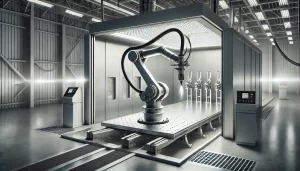When it comes to finishing a surface with a flawless coat of paint, every detail matters—from air pressure to humidity, and even how clean your workspace is. In a controlled environment like a paint booth, things should be perfect, right? Yet even in this ideal setting, many painters still run into a frustrating issue: uneven paint application.
Uneven paint jobs can ruin the final look, waste materials, and force time-consuming rework. And whether you’re painting cars, cabinets, or industrial equipment, no one wants that. So what’s behind this common problem? Let’s explore the typical culprits behind uneven paint finishes in a paint booth and how to prevent them.
It All Starts With Airflow
One of the biggest reasons for uneven paint application in a booth is poor airflow. A good paint booth is designed to manage air movement in a way that helps distribute paint evenly. When airflow is disrupted, it can cause paint to settle more in some areas and less in others. You might see streaking, patchiness, or even rough texture.
This often happens when filters are clogged, vents are blocked, or the exhaust fan isn’t working properly. Without smooth, consistent airflow, overspray can float around the booth and land unpredictably. Over time, this not only affects the finish but also creates a build-up of dust and paint particles that can contaminate future jobs.
Spray Gun Settings Matter More Than You Think
Another common issue is incorrect spray gun settings. If the pressure is too low, the paint won’t atomize properly, leading to a blotchy or speckled finish. Too much pressure, and the paint might go on too thin or create runs and sags.
Even something as simple as the wrong spray pattern or nozzle size can cause trouble. Different jobs require different setups, and using a one-size-fits-all approach can easily lead to uneven results. It’s always worth checking your gun’s calibration before starting a new project, even if you’ve just used it the day before.
Don’t Overlook the Substrate
Sometimes the problem isn’t with the booth or the equipment—it’s with the surface being painted. If the material hasn’t been cleaned or prepped properly, paint might not adhere evenly. Oils, dust, old paint, or moisture can all create a barrier between the new coat and the surface.
Sanding is another key step. A surface that’s too smooth might cause paint to slide off, while a surface that’s too rough can absorb too much paint in some areas and too little in others. In both cases, you’ll be left with a finish that’s far from uniform.
Lighting Isn’t Just About Seeing Clearly
Lighting might not seem like a major factor, but in the world of painting, it’s crucial. Dim or uneven lighting inside the booth can make it hard to spot mistakes as they happen. If you’re relying on shadows or moving your head to see angles, you’re more likely to miss areas or overcompensate by applying more paint than needed.
Modern paint booths usually come with proper LED lighting for a reason—it helps the painter see the job clearly and make more consistent passes. Poor lighting doesn’t directly affect how the paint goes on, but it does impact how you apply it, which makes a difference in the final result.
Temperature and Humidity Can Be Sneaky
Paint doesn’t like surprises. Fluctuations in temperature or humidity levels inside the booth can cause the paint to dry too quickly or too slowly. This not only affects coverage but also the way layers stick together.
If it’s too humid, moisture can mix with the paint and change its texture. If it’s too dry or hot, the paint might start drying in the air before it even hits the surface. The result? An uneven coat that looks dusty, patchy, or dull. Always check your booth’s climate controls before spraying—and give it time to stabilize if the conditions aren’t ideal.
The Human Factor
Technique plays a big role in any paint job, no matter how advanced your equipment is. Inconsistent hand speed, changing the distance between the spray gun and the surface, or not overlapping passes correctly can all result in uneven application.
Fatigue is another silent contributor. Long hours in the booth can affect concentration and muscle control. Even experienced painters can start rushing or cutting corners without realizing it, especially when trying to meet tight deadlines.
Good training, clear procedures, and taking short breaks during long jobs can help maintain consistency from start to finish.
Maintenance Makes a Difference
Let’s face it—paint booths are hardworking environments. And just like any piece of equipment, they need regular maintenance. Filters should be changed regularly. Booth walls should be cleaned to prevent contamination. Spray guns should be disassembled and cleaned often to avoid blockages or worn-out parts that mess with spray patterns.
When maintenance is skipped or delayed, performance slowly declines. Things might seem fine at first, but over time, small problems build up until they start affecting paint quality in obvious ways.
Simple Fixes That Go a Long Way
Preventing uneven paint application doesn’t always require high-tech solutions. Sometimes it’s about going back to basics:
- Pre-checks before every job – Look at your booth’s airflow, temperature, and lighting.
- Test your spray gun – Do a trial spray on scrap material to confirm settings.
- Prep your surface – Clean and sand it properly to ensure good adhesion.
- Stick to technique – Keep your distance and overlap passes consistently.
- Maintain your equipment – Keep everything clean and functioning properly.
Small steps like these can go a long way in ensuring that each coat goes on smoothly and evenly, saving you time, materials, and frustration.
Conclusion
Uneven paint application in a booth isn’t just one problem—it’s a combination of factors that often work together. The good news is that once you understand what’s causing the issue, it becomes much easier to fix. Whether it’s airflow, equipment settings, or the painter’s own rhythm, there’s usually a clear path to getting better results.
At the end of the day, a paint booth is only as good as the attention it’s given. With the right setup, consistent practices, and routine maintenance, achieving a smooth, even finish becomes a whole lot more predictable—and a lot less stressful.
How We Can Help with Your Paint Booth Needs
At Paint Booth, we specialize in providing top-tier paint booths and finishing equipment tailored to your business requirements. Whether you need a standard-size paint booth or a custom solution designed for your unique projects, our expert team is here to assist you every step of the way. From design to installation, we ensure that your equipment meets the highest industry standards, enhancing both your productivity and the quality of your finishes. Contact us today to find the perfect paint booth solution for your business!




